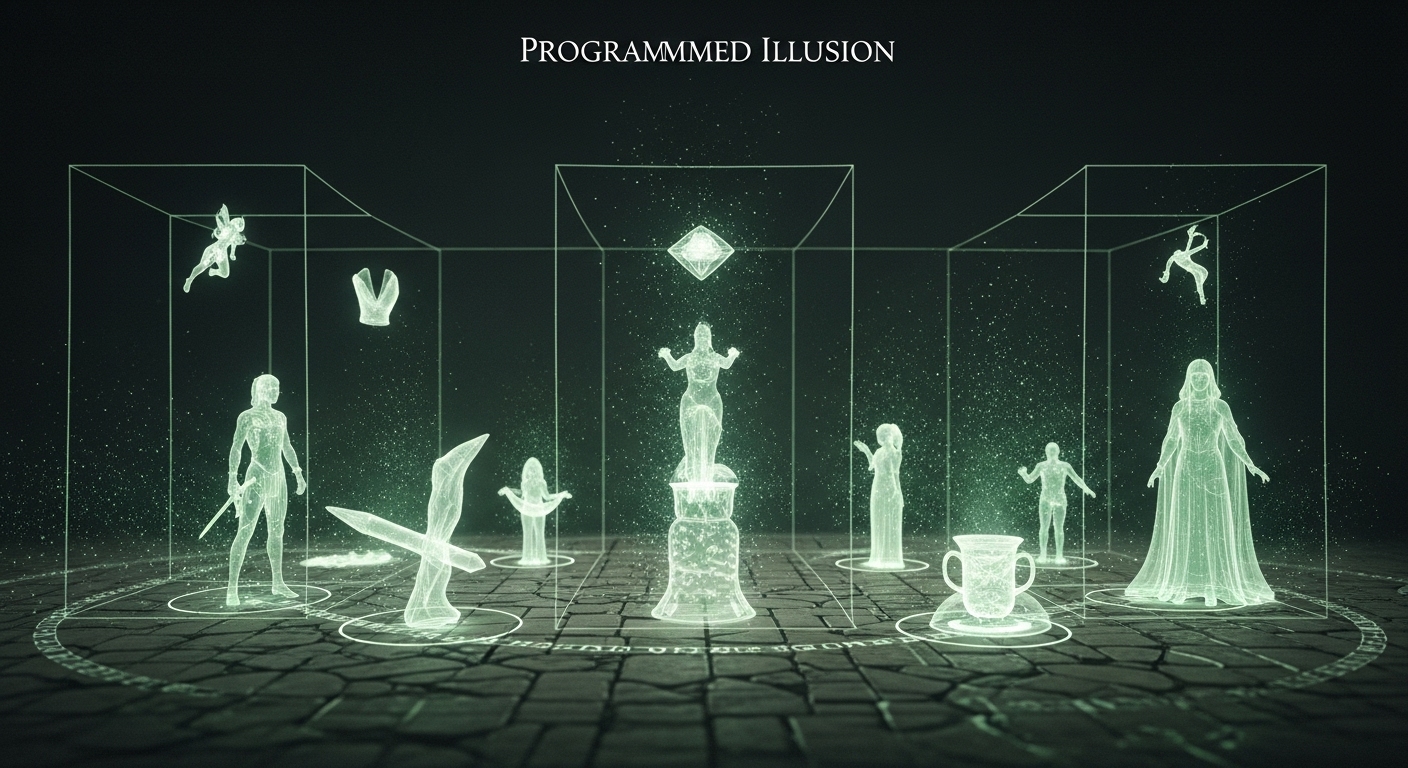Programmed Illusion

- Level: 6
- School: Illusion
- Class: Bard, Wizard
- Casting Time: Action
- Range: 120 feet
- Components: V, S, M (jade dust worth 25+ GP)
- Duration: Until dispelled
You create an illusion of an object, a creature, or some other visible phenomenon within range that activates when a specific trigger occurs. The illusion is imperceptible until then. It must be no larger than a 30-foot Cube, and you decide when you cast the spell how the illusion behaves and what sounds it makes. This scripted performance can last up to 5 minutes.
When the trigger you specify occurs, the illusion springs into existence and performs in the manner you described. Once the illusion finishes performing, it disappears and remains dormant for 10 minutes, after which the illusion can be activated again.
The trigger can be as general or as detailed as you like, though it must be based on visual or audible phenomena that occur within 30 feet of the area. For example, you could create an illusion of yourself to appear and warn off others who attempt to open a trapped door.
Physical interaction with the image reveals it to be illusory, since things can pass through it. A creature that takes the Study action to examine the image can determine that it is an illusion with a successful Intelligence (Investigation) check against your spell save DC. If a creature discerns the illusion for what it is, the creature can see through the image, and any noise it makes sounds hollow to the creature.
Tactical Usage
Automated Illusion System. Programmed Illusion creates persistent, trigger-activated illusions that provide ongoing security, communication, or distraction without requiring caster presence or concentration.
Trigger-Based Activation. The customizable trigger system enables precise control over when illusions activate, creating sophisticated security systems or automated responses to specific situations.
Extended Performance Capability. Five-minute scripted performances allow complex illusions that can deliver detailed messages, create elaborate distractions, or simulate extended activities.
Spell Combinations
Security System Integration. Combining with alarm spells, protective wards, or other triggered effects creates comprehensive security systems that respond automatically to intrusion attempts.
Information Delivery. Coordinating with communication spells or magical messaging systems enables sophisticated information networks that activate based on predetermined conditions.
Area Denial Support. Pairing with actual hazards or protective spells creates psychological deterrents that reinforce real threats with convincing illusions.
Material Component Details
Jade Dust Investment. The 25+ gold piece jade dust requirement represents moderate investment but provides unlimited duration until dispelled, making it cost-effective for permanent installations.
Component Preparation. Jade dust can be prepared by grinding jade gems or purchased from alchemical suppliers, though quality considerations might affect component effectiveness.
Symbolic Significance. Jade's traditional associations with protection and permanence make it thematically appropriate for creating persistent magical effects.
Creator Notes
Persistent Plot Tool. Programmed Illusion enables ongoing narrative elements that can trigger months or years after initial casting, creating long-term story hooks and surprises.
Automated Encounter Elements. The spell provides excellent mechanisms for creating dynamic encounters that respond to party actions without requiring Creator management.
Reusable Activation. The 10-minute dormancy period before reactivation allows repeated use while preventing abuse through constant triggering.
Environmental Interactions
Visual and Audible Triggers. Trigger conditions must be based on observable phenomena within 30 feet, enabling creative but realistic activation requirements.
Large Area Coverage. The 30-foot cube maximum size allows substantial illusions that can fill rooms, create convincing outdoor scenes, or simulate multiple creatures.
Physical Interaction Limits. Objects and creatures pass through illusions, though Investigation checks provide opportunities for detection by careful observers.
Common Rulings & Clarifications
Trigger Specificity. Triggers can range from general conditions to highly specific requirements, enabling both broad activation and precise control mechanisms.
Performance Scripting. Illusions follow predetermined scripts rather than improvising, requiring careful planning during casting to address likely scenarios.
Dormancy Period. After performing, illusions remain inactive for 10 minutes before becoming available for reactivation, preventing continuous operation.
Detection Methods. Physical interaction immediately reveals illusions, while Investigation checks allow discernment through careful examination.
Alternative Applications
Educational Tools. Creating instructional illusions that demonstrate techniques, historical events, or important information when triggered by appropriate conditions.
Warning Systems. Establishing automated warning messages that activate when specific threats or conditions are detected in protected areas.
Entertainment Venues. Designing interactive entertainment experiences that respond to audience actions with predetermined performances and effects.
Related Spells
Illusion Magic Progression. Silent Image and Major Image provide active illusion control, while Programmed Illusion offers automation at the cost of real-time control.
Trigger Magic. Glyph of Warding and similar spells provide alternative approaches to conditional magic activation with different capabilities and limitations.
Persistent Magic. Permanent illusions like Mirage Arcane offer different approaches to long-term illusion effects with varying scope and control mechanisms.
Scaling Analysis
Permanent Duration Value. Until dispelled duration provides exceptional value for a 6th-level slot when creating long-term installations or ongoing story elements.
Complex Trigger Systems. Higher-level access enables sophisticated conditional magic that can create elaborate automated responses to changing circumstances.
Campaign Integration. The spell becomes increasingly valuable for characters managing territories, organizations, or long-term strategic operations requiring automated responses.
Narrative Flavor
Scripted Reality. Programmed illusions should feel like carefully rehearsed performances that activate precisely according to their predetermined scripts.
Trigger Responsiveness. The moment of activation offers dramatic opportunities as dormant magic suddenly springs to life in response to specific conditions.
Persistent Magic Presence. Areas containing programmed illusions should hint at magical preparation, with subtle signs that magical effects await proper activation conditions.